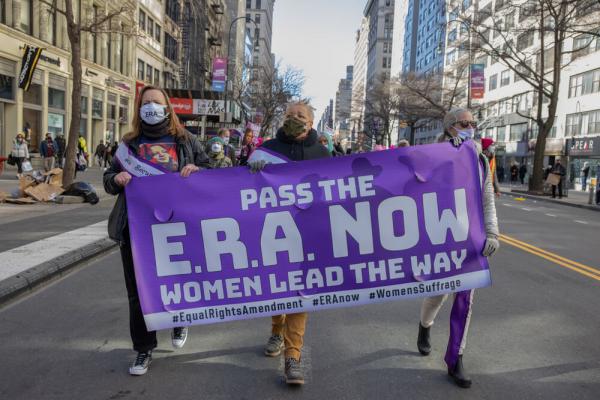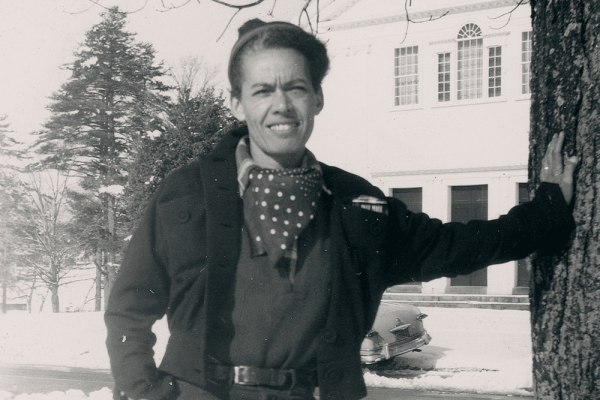Most Christians in the United States don’t know about the faith-based roots of the Equal Rights Amendment.
Our foremothers believed God created all humans in God’s own image (Genesis 1:27) and they worked to ensure the inherent dignity and worth of every person. During the 19th and 20th centuries, Black women organized through churches in the struggle for universal suffrage and equal rights. White women also formed powerful alliances rooted in their faith.
Too often, white suffragists allowed their whiteness to overrule their Christian witness, as when the National American Woman Suffrage Association barred Black organizers from the convention. Mary Church Terrell, a member of the African Methodist Episcopal Church, challenged the NAWSA's segregation policies. Terrell became the first president of the National Association of Colored Women to promote women’s equality.
Out of these streams came the National Women’s Party under the leadership of Irish Catholic Lucy Burns and Quaker Alice Paul. Burns and Paul worked closely with Terrell on various causes. In this context, Paul and Crystal Eastman, the daughter of one of the first women ordained as a Protestant minister in the United States, penned the first language of the Equal Rights Amendment.
This year, we are one step away from the ERA becoming the 28th Amendment to the U.S. Constitution. The intent of this new amendment is simple: The ERA's guarantee of equal rights would protect women, men, and LGBTQ people, as respective classes, against sex discrimination under the law.
Here is the text of the amendment in its entirety:
Section 1. Equality of rights under the law shall not be denied or abridged by the United States or by any State on account of sex. Section 2. The Congress shall have the power to enforce, by appropriate legislation, the provisions of this article. Section 3: This amendment shall take effect two years after the date of ratification.
While the proposed amendment is succinct, misconceptions about it abound. Here are just a few of the common questions we've heard.
Misconception #1: Doesn’t the U.S. Constitution already fully protect women and LGBTQ people from discrimination?
Many believe that the ERA is unnecessary because the 14th Amendment states that all citizens must be offered equal protection under the law. However, some jurists argue otherwise. In a 2011 interview, the late Justice Antonin Scalia claimed that “The only issue is whether [the Constitution] prohibits [discrimination on the basis of sex]. It doesn't. Nobody ever thought that that's what it meant.” Scalia’s originalist interpretation of the Constitution influenced his reading of the 14th Amendment as well. Other court justices and U.S. citizens continue to be influenced by Scalia’s reading which leads them to conclude that the 14th Amendment’s Equal Protection Clause does not necessarily extend to women or LGBTQ persons as that interpretation is beyond the scope of its original intention. Because there are justices who agree with this interpretation, we need the ERA to make protection against gender discrimination explicit in the Constitution and to ensure that women and LGBTQ people have equal rights under the law. Until we add the ERA to the Constitution, the debate around the 14th Amendment puts 50 years of progress for women at risk.
Misconception #2: Won’t the ERA leave women less protected than they are now?
Some believe that the ERA would eliminate legal protections specific to women. Contrary to this belief, the ERA would not ban the government from creating laws and protections that draw distinctions based on sex. Rather, it would require a strong justification when using sex as the basis for creating restrictions. For example, the ERA would justify creating a single-sex shelter for women survivors of domestic or intimate partner violence in order to protect survivors against gender-based trauma. Having equal rights under the law does not erase human differences, gender or otherwise. Instead, gender equality ensures that the government cannot use those differences to make life harder for women and other minorities. The ERA simply ensures that legislation doesn’t put women and gender minorities at a disadvantage.
Misconception #3: Won’t protecting women and LGBTQ people against discrimination based on sex threaten the Constitution’s longstanding protections for religious liberty?
Religious freedom is a founding principle and core value of the United States, and the First Amendment is not going anywhere. In recent years, we’ve seen the Supreme Court protect religious freedom with fervor — even extending it to for-profit corporations in their role as employers. Since the Supreme Court’s 2015 Obergefell v. Hodges decision that legalized gay marriage, churches and pastors have still been free to decide whether to officiate or host a gay wedding according to their theology or church doctrine. We see no risk of the current Supreme Court shirking from its constitutional duty to give religion due consideration. Congress, likewise, has shown its willingness to protect religious freedom, passing legislation to ensure it receives the highest measure of legal protection.
We can also see from comparable countries' experiences that greater support for women and LGBTQ rights aligns with greater religious freedom protections. A study by Brian J. Grim at the Religious Freedom and Business Foundation found that “the average level of religious freedom is 36% higher in the countries with higher levels of support for LGBT rights than in countries with low levels of support for LGBT rights.” The expansion of human rights is good for religious freedom. This shouldn’t surprise us: A culture that values human rights for women and LGBTQ people will also value human rights for religious people.
People of faith should be for the ERA
As people of faith, we affirm that freedom of religion is a vital human right that should be protected. Yet religious freedom, like every other right, has its limits; it must not be misused to shield harmful practices. Inherent rights cannot be separated from communal responsibility. In the gospel, Jesus says that the greatest commandments is to love our neighbor and to care for others (Matthew 7:12). When we assert our rights, we must also respect the dignity and rights of our neighbors. As Christians, we have a long history of forgetting that responsibility, which has led to oppressing women, non-Christians, LGBTQ people, and others.
One of the concrete ways we care for our neighbors is by ensuring that all people, regardless of gender or sexuality, have fair access to the things that everyone needs. We must make sure there are legal protections that allow everyone to access safe housing, employment, freedom to build their family, and the dignity and safety of never being turned away from a store or hospital due to their sexuality or gender. This is why as Christians we support the expansion of human rights and civil rights for everyone, including women, LGBTQ people, and people of every religion, or no religion. This is how we intervene against the suffering caused by injustice.
Got something to say about what you're reading? We value your feedback!









